Museo Nacional de Bellas Artes (Buenos Aires)
The Museo Nacional de Bellas Artes ("National Museum of Fine Arts") is an Argentine art museum in Buenos Aires, located in the Recoleta section of the city. The Museum inaugurated a branch in Neuquén in 2004. The museum hosts works by Goya, Rembrandt, Van Gogh, Rodin, Manet and Chagall among other artists.
.jpg.webp) Facade of the museum in 2017  Location within Buenos Aires | |
Interactive fullscreen map | |
| Established | 25 December 1896 |
|---|---|
| Location | Avenida del Libertador 1473 Buenos Aires, Argentina |
| Coordinates | 34°35′2.6″S 58°23′34.1″W |
| Type | Art museum |
| Director | Andrés Duprat |
| Website | bellasartes.gob.ar |
History

Argentine painter and art critic Eduardo Schiaffino, was the first director of the museum, which opened on 25 December 1895, in a building on Florida Street that today houses the Galerías Pacífico shopping mall. In 1909, the museum moved to a building in Plaza San Martín, originally erected in Paris as the Argentine Pavilion for the 1889 Paris exhibition, and later dismantled and brought to Buenos Aires. In its new home, the museum became part of the International Centenary Exhibition held in Buenos Aires in 1910. Following the demolition of the pavilion in 1932, as part of the remodeling of Plaza San Martín, the museum was transferred to its present location in 1943, a building originally constructed in 1870 as a drainage pumping station and adapted to its current use by architect Alejandro Bustillo.
The museum was modernized both physically and in its collections during the 1955–64 tenure of director Jorge Romero Brest. A temporary exhibits pavilion opened in 1961, and the museum acquired a large volume of modern art though its collaboration with the Torcuato di Tella Institute, a leading promoter of local, avant-garde artists, and elsewhere; a contemporary Argentine art pavilion opened in 1980. This 1,536 square metres (16,533 sq ft) hall is the largest of 34 currently in use at the museum, which totals 4,610 square metres (49,622 sq ft) of exhibit space. Its permanent collection totals 688 major works and over 12,000 sketches, fragments, potteries, and other minor works. The institution also maintains a specialized library, totaling 150,000 volumes, as well as a public auditorium. The museum commissioned architect Mario Roberto Álvarez to design a branch in the Patagonian region city of Neuquén. Inaugurated in 2004, this museum has four exhibit halls totaling 2,500 square metres (26,910 sq ft) and a permanent collection of 215 works, as well as temporary exhibits and a public auditorium.
The ground floor of the museum holds 24 exhibit halls housing a fine international collection of paintings from the Middle Ages up to the 20th century, together with the museum's art history library. The first floor's eight exhibit halls contain a collection of paintings by some of the most important 20th-century Argentine painters, including Antonio Berni, Ernesto de la Cárcova, Benito Quinquela Martín, Eduardo Sívori, Sarah Grilo, Alfredo Guttero, Raquel Forner, Xul Solar, Marcelo Pombo and Lino Enea Spilimbergo. The second floor's two halls, completed in 1984, hold an exhibition of photographs and two sculpture terraces, as well as most of the institution's administrative and technical departments.
Gallery
 Flemish Baroque, Allegory of Fortune and Virtue, Rubens, 17th century
Flemish Baroque, Allegory of Fortune and Virtue, Rubens, 17th century Dutch Baroque, Portrait of Young Woman, Rembrandt, 1634
Dutch Baroque, Portrait of Young Woman, Rembrandt, 1634 Dutch Baroque, Landscape with the Ruins of the Abbey of Rijnsburg, Cuyp, 1645
Dutch Baroque, Landscape with the Ruins of the Abbey of Rijnsburg, Cuyp, 1645 Argentine naturalism, A Stop in the Countryside, Pueyrredón, 1861
Argentine naturalism, A Stop in the Countryside, Pueyrredón, 1861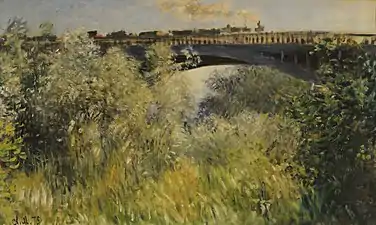 French Impressionism, The Bridge of Argenteuil, Monet, 1875
French Impressionism, The Bridge of Argenteuil, Monet, 1875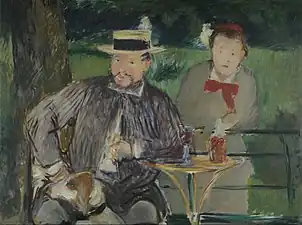 French naturalism, Portrait of Ernest Hoschedé and his daughter Martha, Manet, 1876
French naturalism, Portrait of Ernest Hoschedé and his daughter Martha, Manet, 1876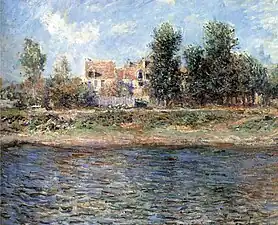 French Impressionism, The Banks of the Seine, Monet, 1880
French Impressionism, The Banks of the Seine, Monet, 1880_-_Google_Art_Project.jpg.webp)
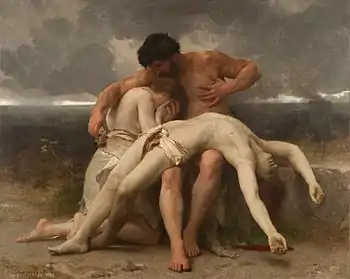 French academic art, The First Mourning, Bouguereau, 1888
French academic art, The First Mourning, Bouguereau, 1888 Argentine naturalism, Interior view of Curuzú looked upstream, López, 1891
Argentine naturalism, Interior view of Curuzú looked upstream, López, 1891.jpg.webp) Argentine naturalism, The return of the malón, Della Valle, 1892
Argentine naturalism, The return of the malón, Della Valle, 1892 Argentine naturalism, After the Battle of Curupaytí, López, 1893
Argentine naturalism, After the Battle of Curupaytí, López, 1893 Argentine naturalism, Without bread and without work, Cárcova, 1894
Argentine naturalism, Without bread and without work, Cárcova, 1894 French Impressionism, Dancers and Two Yellow Roses, Degas, 1898
French Impressionism, Dancers and Two Yellow Roses, Degas, 1898
_-_Google_Art_Project.jpg.webp) Argentine Impressionism, The Haystacks (The Pampa of Today), Malharro, 1911
Argentine Impressionism, The Haystacks (The Pampa of Today), Malharro, 1911 German symbolism, Batsheba, Stuck, 1912
German symbolism, Batsheba, Stuck, 1912
 Flemish Renaissance, The Birth of Virgin Mary, Oostanen, late 15th or early 16th century
Flemish Renaissance, The Birth of Virgin Mary, Oostanen, late 15th or early 16th century Flemish Baroque, Portrait of Margarita Gonzaga, Pourbus (the Younger), 1603
Flemish Baroque, Portrait of Margarita Gonzaga, Pourbus (the Younger), 1603 Spanish Baroque, An astronomer, Ribera, 1617–1652
Spanish Baroque, An astronomer, Ribera, 1617–1652 Spanish Baroque, Saint Francis in Meditation, Zurbarán, 1632
Spanish Baroque, Saint Francis in Meditation, Zurbarán, 1632 Mexican Baroque, The Conquest of Mexico. Table VIII, Gonzales, 1696/1715
Mexican Baroque, The Conquest of Mexico. Table VIII, Gonzales, 1696/1715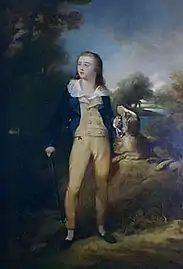 Scottish academic art, Master Cathcart and Dog, Raeburn, 1810
Scottish academic art, Master Cathcart and Dog, Raeburn, 1810 Argentine naturalism, Portrait of Manuelita Rosas, Pueyrredón, 1851
Argentine naturalism, Portrait of Manuelita Rosas, Pueyrredón, 1851 French naturalism, The Surprised Nymph, Manet, 1861
French naturalism, The Surprised Nymph, Manet, 1861 French Impressionism, Le Moulin de la Galette, Van Gogh, 1886–1887
French Impressionism, Le Moulin de la Galette, Van Gogh, 1886–1887 Argentine naturalism, The Maid's Awakening, Sívori, 1887
Argentine naturalism, The Maid's Awakening, Sívori, 1887 Argentine Post-Impressionism, The Presentation, Thibon de Libian, 1918
Argentine Post-Impressionism, The Presentation, Thibon de Libian, 1918 Argentine return to order, Annunciation, Guttero, 1928
Argentine return to order, Annunciation, Guttero, 1928
External links
- Official website

- Asociación Amigos Museo Nacional de Bellas Artes (in Spanish)
- Virtual tour of the Museo Nacional de Bellas Artes provided by Google Arts & Culture
 Media related to Museo Nacional de Bellas Artes (Argentina) at Wikimedia Commons
Media related to Museo Nacional de Bellas Artes (Argentina) at Wikimedia Commons